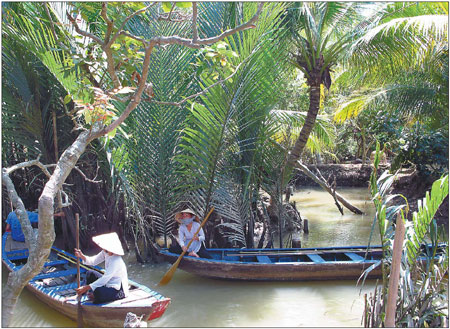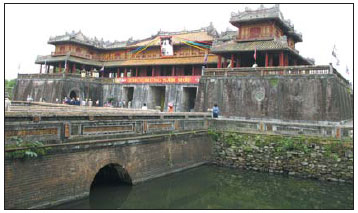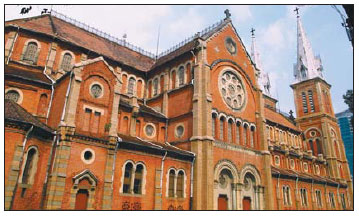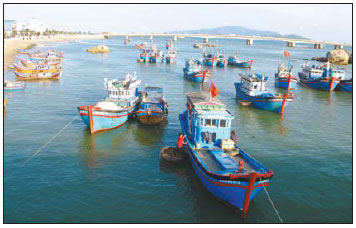Savoring Vietnam, from north to south
 |
|
A two-day tour to Mekong Delta offers a glimpse of the traditional Vietnamese way of life. Photos by Zhang Zixuan / China Daily |
After falling in love with Vietnam-style pork rolls in Sydney, it was time to savor the country first hand, Zhang Zixuan decided.
My first impression of Vietnam didn't come from the well-known French novel, The Lover by Marguerite Duras, but from a common Vietnamese snack that was my comfort food in Sydney for two years. It's a baguette cut in half and filled with sliced pork, ham, meatballs, egg, coriander, cucumber, pickled carrot, soy sauce, mayonnaise, butter and chili.
I loved it after the first bite, especially the little red and extremely hot Vietnamese chili that exploded on the tip of my tongue.
In Sydney it's called pork roll and I often used to have a pleasant chat with the Vietnamese woman who made the rolls. She insisted I should visit her homeland one day, so I did.
I traveled from the north to the south by bus and the words of my Vietnamese friend in Sydney, that the pork rolls could be found all over the country, proved correct. Called banh mi pate in Vietnamese, eating two a day became a daily routine during my 14-day trip.
One of the other charms of the S-shaped country is the smell of incense that floats in the air and I discovered that joss sticks were burned everywhere, in the bus on long-distance journeys, at mini altars in shops and on crowded street corners.
Although there are churches in many cities, there are just as many, if not more, temples and the influence of Buddhism is profound.
At every temple I visited, including Long Son Pagoda in Nha Trang, devout Vietnamese leave their shoes outside the door, walk barefoot and kneel in front of the Buddha statue for hours.
The smell of incense combines with the scent of fresh herbs, or even fish sauce from countless street food vendors and it is a heady combination.
Beverage vendors' stands are fairly simple, with a few bottles of soft drinks, several cups filled with ice and a couple of plastic stools. Chewing ice on a pink plastic stool might not look so elegant as sitting at an open-air cafe in Europe, but the joy it brings to locals, and visitors is just as great.
As to food vendors, their stools are never empty, especially at night. Passers-by take a seat and eat, without saying anything. Beautiful Vietnamese girls who wear traditional ao dai do the same, without worrying about staining their silk dresses.
As a tourist, speaking English or French can be a disadvantage here, as vendors can often charge higher prices, though it should be added some locals were the opposite and were likely to be kinder to a foreign face.
For instance, a Vietnamese young man paid my bill in Hoi An when I was bargaining with a vendor. I didn't even have the chance to thank him.
The warm-heartedness of Vietnamese was evident when I failed to cross a street after trying to do so for 15 minutes.
The streets, as many guide books and videos attest, are chaotic. I was often helped by a sympathetic local carrying a shoulder pole, who would make a sign to follow him, safely, across the road.
The army of moped riders makes a significant contribution to the life of ordinary Vietnamese, transporting goods and services. Their helmets and facemasks are often fashion statements and provide a colorful opportunity to show off their individuality.
While the Vietnamese way of life is always evident, there were a lot of foreign faces and this showed how important the tourism industry is to the country.
There are numberless guesthouses, while fake "Sinh Cafe" tour buses shuttle among cities, and free Wifi is available even in the rural areas of Mekong Delta.
The scenic diversity of the country made it all worthwhile. After showing my friends photos of myself enjoying the water puppet show in Hanoi, having a mud bath in Nha Trang, and running on the white sand dunes in Mui Ne, it was easy to persuade others to pack their bags and make the journey themselves.
|
|
|
Royal Citadel, a World Heritage site, was the imperial capital of the Nguyen Dynasty between 1802 and 1945 in Hue. |
|
|
|
A street food vendor does brisk business in Hoi An. |
|
|
|
Notre Dame Cathedral in Ho Chi Minh City. |
|
|
|
Fishing boats at Nha Trang. |
 0
0 











Go to Forum >>0 Comments